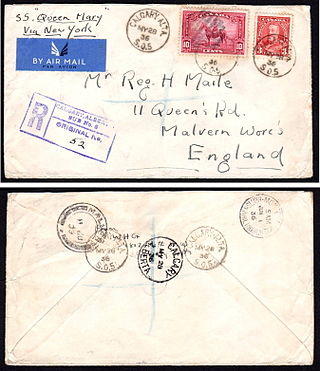Related Research Articles

The United States Postal Service (USPS), also known as the Post Office, U.S. Mail, or Postal Service, is an independent agency of the executive branch of the United States federal government responsible for providing postal service in the U.S., its insular areas, and its associated states. It is one of the few government agencies explicitly authorized by the Constitution of the United States. As of 2023, the USPS has 525,469 career employees and 114,623 non-career employees.
FIPS state codes were numeric and two-letter alphabetic codes defined in U.S. Federal Information Processing Standard Publication 5-2 to identify U.S. states and certain other associated areas. The standard superseded FIPS PUB 5-1 on May 28, 1987, and was superseded on September 2, 2008, by ANSI standard INCITS 38:2009.

Registered mail is a postal service in many countries which allows the sender proof of mailing via a receipt and, upon request, electronic verification that an article was delivered or that a delivery attempt was made. Depending on the country, additional services may also be available, such as:
POSTNET is a barcode symbology used by the United States Postal Service to assist in directing mail. The ZIP Code or ZIP+4 code is encoded in half- and full-height bars. Most often, the delivery point is added, usually being the last two digits of the address or PO box number.
Franking comprises all devices, markings, or combinations thereof ("franks") applied to mails of any class which qualifies them to be postally serviced. Types of franks include uncanceled and precanceled postage stamps, impressions applied via postage meter, official use "Penalty" franks, Business Reply Mail (BRM), and other permit Imprints (Indicia), manuscript and facsimile "franking privilege" signatures, "soldier's mail" markings, and any other forms authorized by the 192 postal administrations that are members of the Universal Postal Union.

A post office box is a uniquely addressable lockable box located on the premises of a post office.

The system for mail delivery in the United States has developed with the nation. Rates were based on the distance between sender and receiver in the early years of the nation. In the middle of the 19th century, rates stabilized to one price regardless of distance. Rates were relatively unchanged until 1968, when the price was increased every few years by a small amount. Comparing the increases with a price index, the price of a first class stamp has been steady. The seal of the Post Office Department showed a man on a running horse, even as railroads and, later, motorized trucks and airplanes moved mail. In 1971, the Post Office became the United States Postal Service, with rates set by the Postal Regulatory Commission, with some oversight by Congress. Air mail became standard in 1975. In the 21st century, prices were segmented to match the sorting machinery in use; non-standard letters required slightly higher postage.
Information-Based Indicia (IBI) is a secure postage evidencing standard used by the United States Postal Service (USPS) to indicate electronic postage payment.
A Prohibitory Order is a legal instrument issued by the United States Postal Service, against a mailer, on request of a recipient. Its effect is to criminalize any further attempt by a particular mailer to continue to send advertisement material to a particular recipient through the United States Postal Service. In addition, it demands that the mailer delete immediately the names of the particular recipient from all mailing lists owned or controlled by the mailer or his agents or assigns and, further, prohibits the mailer and his agents or assigns from the sale, rental, exchange, or other transaction involving mailing lists bearing the names of the particular recipient. It is requested by filing United States Postal Service Form 1500, either with a local Postmaster, or directly with the Prohibitory Order Processing Center.
Post offices and other mail service providers typically offer a mail forwarding service, commonly known as hybrid mail or virtual post office box services, to redirect mail addressed to one location to another address – usually for a given period. In the case of the United States Postal Service's First Class Mail, it is generally for a period of one year. British Royal Mail provides a service called Mail Redirection, enabling redirection for up to two years. Customers of such a service usually, but not exclusively, use mail forwarding when they change an address.

Military mail, as opposed to civilian mail, refers to the postal services provided by armed forces that allow serving members to send and receive mail. Military mail systems are often subsidized to ensure that military mail does not cost the sender any more than normal domestic mail. In some cases, military personnel in a combat zone may post letters and packages to their home country free of charge. Modern military mail services are provided by most armed forces around the world. In some nations, individual service branches may run their own military mail program.

Parcel post is a postal service for mail that is too heavy for normal letter post. It is usually slower than letter post. The development of the parcel post is closely connected with the development of the railway network which enabled parcels to be carried in bulk, to a regular schedule and at economic prices. Today, many parcels also travel by road and international shipments may travel by sea or airmail.

The United States Postal Service uses the words "flats" and "nonletters" interchangeably to refer to large envelopes, newsletters, and magazines.
A Digital Postmark (DPM) is a technology that applies a trusted time stamp issued by a postal operator to an electronic document, validates electronic signatures, and stores and archives all non-repudiation data needed to support a potential court challenge. It guarantees the certainty of date and time of the postmarking. This global standard was renamed the Electronic Postal Certification Mark (EPCM) in 2007 shortly after a new iteration of the technology was developed by Microsoft and Poste Italiane. The key addition to the traditional postmarking technology was integrity of the electronically postmarked item, meaning any kind of falsification and tampering will be easily and definitely detected.
In the United States, a postal holiday is a federal holiday recognized by the United States Postal Service, during which no regular mail is delivered, however Priority Mail Express items will still be delivered as that service functions year round.

The Intelligent Mail Barcode (IMb) is a 65-bar barcode for use on mail in the United States. The term "Intelligent Mail" refers to services offered by the United States Postal Service for domestic mail delivery. The IM barcode is intended to provide greater information and functionality than its predecessors POSTNET and PLANET. An Intelligent Mail barcode has also been referred to as a One Code Solution and a 4-State Customer Barcode, abbreviated 4CB, 4-CB or USPS4CB. The complete specification can be found in USPS Document USPS-B-3200. It effectively incorporates the routing ZIP Code and tracking information included in previously used postal barcode standards.
Postal address verification is the process used to check the validity and deliverability of a physical mailing address. According to the United States Postal Service, an address is valid if it is CASS-certified, meaning that it exists within the comprehensive list of mailable addresses in their Address Management System. This is different from the credit card Address Verification System (AVS), which is the method used by credit card processors to authenticate ownership of a credit card by verifying that the account on the credit card matches the billing address on file. Credit card AVS does not determine deliverability of an address.
A network distribution center (NDC) is a highly mechanized mail processing plant of the United States Postal Service that distributes standard mail and package services in piece and bulk form.

The United States Postal Service (USPS) provides Priority Mail Express for domestic U.S. delivery, and offers two types of international Express Mail services, although only one of them is part of the EMS standard. One is called Priority Mail Express International and the other service is called Global Express Guaranteed (GXG). The latter has no relation to "EMS" International service as provided by the EMS Cooperative.
References
- ↑ "Domestic Mail Manual; Incorporation by Reference". U.S. Postal Service Documents and Publications. July 31, 2012.
The Postal Service announces the issuance of the Mailing Standards of the United States Postal Service, Domestic Mail Manual (DMM(R)) dated June 24, 2012
- ↑ "Domestic Mail Manual: Availability and Publication". Federal Register . 62 (60). 28 March 1997.
- ↑ Chatfield, Bill (20 December 2012). "New Mailing Standards for Domestic Mailing Services Products". Federal Register . 77 (245).